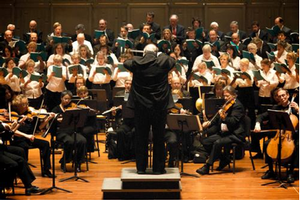Verdi's Requiem visits the Day of Judgment
by Allison Eck '12
EDITOR-IN-CHIEF
If there’s one thing we can say about Giuseppe Verdi, it’s that he was a monumental figure in 19th century Europe. His stature was matched by the monumental nature of his compositions, one of which was the Requiem, a musical setting of the Roman Catholic funeral mass for four soloists, double choir and orchestra. The Hamilton College Oratorio Society will be in the company of the Hamilton College Choir and members of the former Syracuse Symphony Orchestra for a performance of this epic work Tuesday, May 3 at 8 p.m. The work will be conducted by Professor of Music and Oratorio Society Director G. Roberts Kolb.
While the subject of the Requiem is the Day of Judgment —a rather grim topic to address through song—the choice to perform a work by Verdi is actually significant, timely and hopeful: Verdi was a fervent nationalist; his name became widely used as an acronym for Vittorio Emanuele, Rei di Italia (Victor Emanuel, King of Italy), referring to the movement to unite Italy under the rule of the King of Sardinia. In that sense, the upcoming concert is an appropriate rallying cry to combat the circumstances that led to the Syracuse Symphony’s recent declaration of Chapter 7 bankruptcy. The unification of forces (students, professionals and community members) represents a kind of patriotism for one’s immediate cultural network that Verdi would have admired.
 The relationship between the groups involved in this production is a special one, according to Gabe Mollica ’14. “It’s a cool experience to be with not only the Syracuse Symphony members, but it’s also really fun sitting next to the Oratorio singers. I was talking to a former Hamilton professor who got into singing really late. It’s great to see that the power of singing for so many familiar and unfamiliar faces is still strong and affects people even after they’ve retired from their real jobs and raised children.”
The relationship between the groups involved in this production is a special one, according to Gabe Mollica ’14. “It’s a cool experience to be with not only the Syracuse Symphony members, but it’s also really fun sitting next to the Oratorio singers. I was talking to a former Hamilton professor who got into singing really late. It’s great to see that the power of singing for so many familiar and unfamiliar faces is still strong and affects people even after they’ve retired from their real jobs and raised children.”
What makes the music even more dynamic is the concentrated effort it requires on the part of everyone on stage—both professionals and amateurs. Oratorio Society member and Professor of Comparative Literature Peter Rabinowitz noted that the work, which is an “unflinching” portrayal of Judgment, leaves traces of greatness on those who listen to it. “Nobody ever walked out of the Verdi Requiem unshaken,” he said. “He grabs you at the beginning, and he doesn’t let go.”
Cathy Crone ’13 recounted the experience of rehearsing the piece with the orchestra for the first time: “It’s like we’re rehearsing in black and white all semester, and then all of the sudden it’s in color,” she said. “The most dramatic example is the Dies irae [section of the piece], because when you add the orchestra, you have the low brass and the low strings and the timpani—it actually feels as if it’s the day of wrath.”
The contours of the piece are bold and magnificent but, at the same time, subtle. Mollica said that control is necessary to depict fortitude at times when the music is supposed to be quiet and reserved. “You’re always impressed with a choir that can sing really loudly, but it’s when you have 200 people singing really softly is when it’s really awesome,” he said.
Kolb said that because Verdi is remembered most for his operas, listeners might recognize the distinct operatic flavor of the Requiem. The majestic quality of brass playing is particularly important here in that the piece requires eight trumpets (four more than usual). Some of these musicians are elevated or placed backstage to create a “surround sound” effect. “It’s meant to evoke the scriptural reference to the last trumpet sounding on Judgment Day,” he said.
Kolb also commented on the importance of the Syracuse Symphony’s involvement in this endeavor, as well as their numerous other contributions to the quality of music education at Hamilton and in the greater Central New York area. “It’s a great concern for us here,” he said of the orchestra’s disintegration. “These folks are the best instrumental players around, and if they have to go elsewhere to find work, that will have a really bad impact on us too.”
